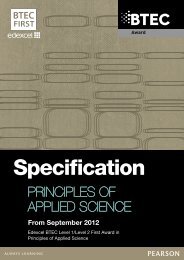BTEC First Award in Application of Science - specification - Edexcel
BTEC First Award in Application of Science - specification - Edexcel
BTEC First Award in Application of Science - specification - Edexcel
You also want an ePaper? Increase the reach of your titles
YUMPU automatically turns print PDFs into web optimized ePapers that Google loves.
UNIT 5: APPLICATIONS OF CHEMICAL SUBSTANCES<br />
What needs to be learnt<br />
Learn<strong>in</strong>g aim B: Investigate organic compounds used <strong>in</strong> society<br />
B.1 Fractional distillation <strong>of</strong> crude oil:<br />
a. fractional distillation <strong>of</strong> crude oil based on boil<strong>in</strong>g ranges <strong>of</strong> components<br />
b. l<strong>in</strong>k between boil<strong>in</strong>g ranges <strong>of</strong> hydrocarbons and length <strong>of</strong> hydrocarbon cha<strong>in</strong><br />
c. uses <strong>of</strong> fractions based on sizes <strong>of</strong> molecules – gases, petrol, kerosene,<br />
diesel oil, fuel oil, bitumens, waxes<br />
d. uses <strong>of</strong> alkanes as fuels – natural gas (methane), bottled gas (propane and<br />
butane), petrol, diesel, kerosene.<br />
B.2 Structural and displayed formulae <strong>of</strong> organic molecules:<br />
a. alkanes – methane, ethane, propane, butane<br />
b. alkenes – structure <strong>of</strong> ethene, propene<br />
c. other organic molecules – poly(ethene), ethanol, ethanoic acid,<br />
chloroethene, poly(chloroethene) (PVC), dichloromethane<br />
d. use <strong>of</strong> a l<strong>in</strong>e to denote a s<strong>in</strong>gle covalent bond/shared pair <strong>of</strong> electrons and<br />
two l<strong>in</strong>es to denote a double bond/two shared pairs <strong>of</strong> electrons.<br />
B.3 Test tube reactions to identify classes <strong>of</strong> organic molecules:<br />
a. alkenes decolourise brom<strong>in</strong>e water (addition)<br />
b. carboxylic acids effervesce when sodium carbonate is added (neutralisation)<br />
c. alcohols oxidised by acidified dichromate (VI) solution which changes from<br />
orange to green (oxidation).<br />
B.4 Uses <strong>of</strong> organic molecules <strong>in</strong> society:<br />
a. ethene <strong>in</strong> the manufacture <strong>of</strong> poly(ethene) and ethanol<br />
b. ethanol (made by fermentation/from ethene) <strong>in</strong> alcoholic dr<strong>in</strong>ks, bi<strong>of</strong>uels,<br />
solvents, cosmetics<br />
c. ethanoic acid <strong>in</strong> v<strong>in</strong>egar and mak<strong>in</strong>g esters<br />
d. dichloromethane <strong>in</strong> pa<strong>in</strong>t stripper and solvents<br />
e. chloroethene <strong>in</strong> polymerisation to PVC and uPVC<br />
f. Teflon TM (PTFE) <strong>in</strong> non-stick coat<strong>in</strong>gs and low-friction bear<strong>in</strong>gs<br />
g. problems <strong>of</strong> organic molecules (toxicity <strong>of</strong> compounds and products formed<br />
on combustion, flammability and non-biodegradability).<br />
BF029957 – Specification – <strong>Edexcel</strong> <strong>BTEC</strong> Level 1/Level 2 <strong>First</strong> <strong>Award</strong> <strong>in</strong> <strong>Application</strong> <strong>of</strong> <strong>Science</strong> –<br />
Issue 1 – March 2012 © Pearson Education Limited 2012<br />
41








